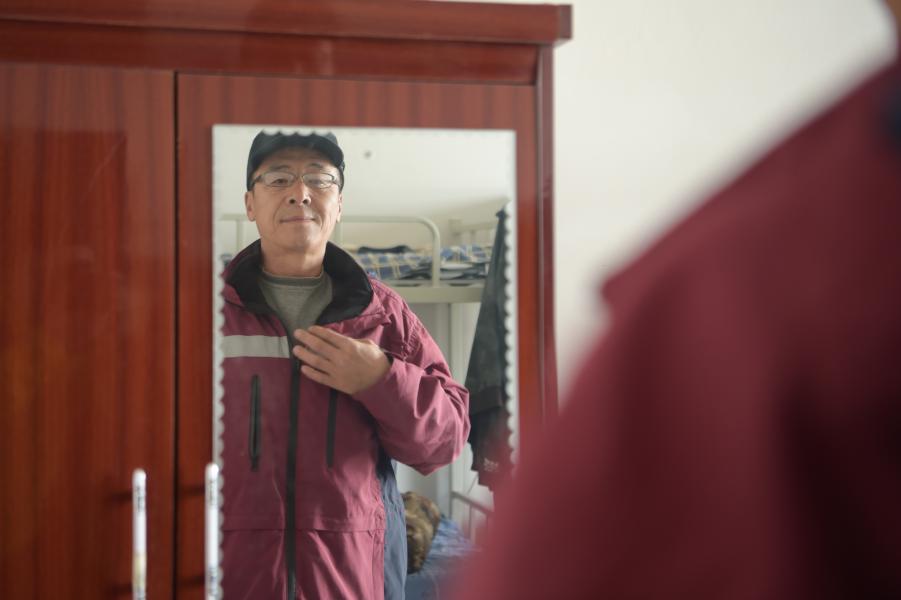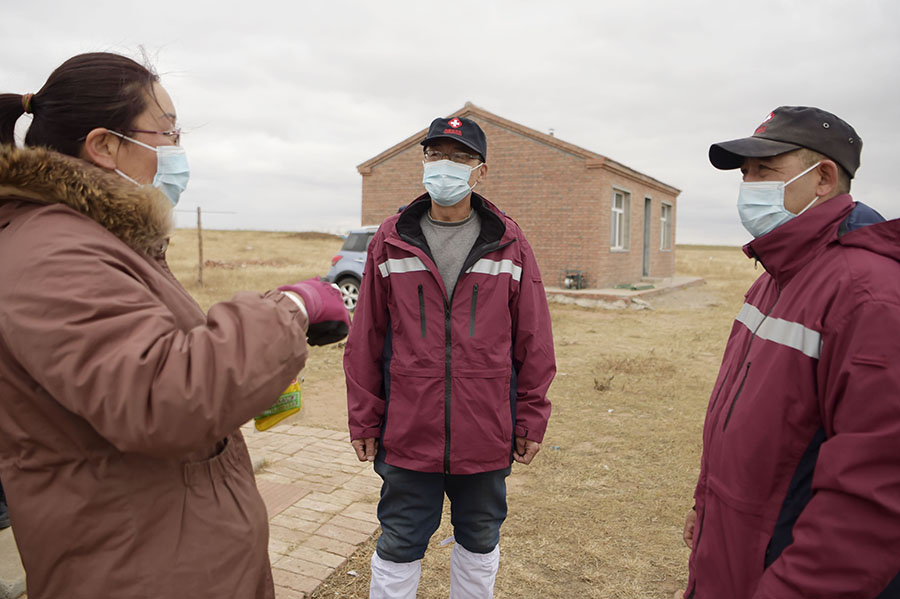

-- Since 1980, frontline epidemic prevention worker Wang Yi has detected five outbreaks of rat-to-rat plague and effectively prevented them from spreading.
-- One generation after another, plague prevention workers have devoted themselves to building the first line of defense against epidemics.
HOHHOT, Oct. 25 (Xinhua) -- Over the past four decades, frontline epidemic prevention worker Wang Yi has been dealing with one thing -- rats.
For nearly six months every year, Wang goes deep into the vast grasslands of north China's Inner Mongolia Autonomous Region to trace the activities of rats, monitoring their species density and catching them for tests.
Since 1980, he has detected five outbreaks of rat-to-rat plague and effectively prevented them from spreading, helping build the first line of defense against the deadly virus.

Wang Yi checks his uniform before going to work at the dorm in West Ujimqin Banner, north China's Inner Mongolia Autonomous Region, Oct. 21, 2020. (Xinhua/Li Zhipeng)
RAT-CATCHER
As a rookie epidemic prevention worker in 1980, Wang was posted at a station in West Ujimqin Banner in central Inner Mongolia.
On his first day on the job, Wang was tasked with laying rat traps alongside an elderly worker. Inexperienced, Wang could only catch two or three rats with 100 traps, while his co-worker could catch more than 30.
"During my break at noon, I would sit quietly aside and get so frustrated with myself that I had no appetite for lunch," Wang recalled.
But Wang is an avid learner and didn't give up easily. Learning from his fellow workers, he gradually mastered a set of rat-catching techniques.
After years of work, he could distinguish over a dozen different kinds of rats, and could even detect the presence of yellow rats, gerbils, or jerboa mice just by looking at the shape of the holes the creatures had made.
For over twenty years, with no permanent plague monitoring site, Wang and his colleagues had to work on a mobile basis.
"We often loaded our car with 300 kg of gasoline, drove off into the grassland and didn't come back for over 10 days until we ran out of gas," he said. The situation finally changed in 2008 when an old grain station was converted into a plague monitoring station.
This spring, the station was equipped with drones that significantly reduced the workload of Wang and his colleagues in the field.
"We used the drone to locate a quadrat covering an area of 1 hectare and took about 150 photos. Assisted by computer software, we could determine the number of rat holes in the quadrat and monitor the species density," said Wang Ruoyu, Wang Yi's co-worker.
"Catching rats is the most fundamental part of plague prevention and control," said Wang Yi. "Field monitoring offers key data for epidemiological analysis."

Wang Yi puts rat traps in West Ujimqin Banner, north China's Inner Mongolia Autonomous Region, Oct. 21, 2020. (Xinhua/Li Zhipeng)
PUBLIC PARTICIPATION
Wang Yi has also made considerable efforts to raise plague prevention awareness among herders and has encouraged their participation in the fight against the plague.
"Combating the plague is never a one-man job," he said. "The information provided by the herders is critical to tracing rats in a vast grassland."
Local herder Oyontogs says he often feels a sense of safety whenever he sees Wang and his colleagues working in the field.
Epidemic prevention workers have taught us a lot about the plague, said Oyontogs. Whenever we find dead rats and cannot determine the cause of their death, we give them a call.
On April 7, 2020, Wang's colleague received a report of dead rats and immediately went to the site to inspect it. The following day, Wang brought back four dead rats for testing and extracted the plague virus from them.
It was the first time in 10 years that the plague had been detected in West Ujimqin Banner. Large-scale sterilization and a virus control campaign immediately began to prevent the virus from being transmitted to humans.
Identifying a plague outbreak requires close coordination between rat-catchers and lab testers.
"The testing work is a race against the clock. We can not call it a day until all the rats caught are examined," said Li Shuqing, director of a local plague lab. Once, Li worked for seven hours on end and dissected nearly 80 rats in that time.

Wang Yi (C) introduces plague prevention measures to a herder in West Ujimqin Banner, north China's Inner Mongolia Autonomous Region, Oct. 21, 2020. (Xinhua/Li Zhipeng)
PASSING DOWN SKILLS
With one year left before his retirement, Wang works on the frontline of plague prevention with just as much dedication as he has always shown. But he also spends more time training young colleagues.
"Before I retire, I want to pass down my skills to my young colleagues. It gives me a greater sense of achievement than catching mice," said Wang.
For Wang, persistence and perseverance are the most important work ethics he learned from his predecessors and also what benefited him the most throughout his career.
"Colleagues who were 20 or 30 years older than me often carried 100 rat traps that weighed over 30 kg for a whole day, but they never complained about their hardship," said Wang.
Odengerel, one of Wang's students, had given up the opportunity to work in a local hospital so that he could be a frontline epidemic prevention worker.
"Plague prevention work must carry on," said Odengerel. "I am determined to learn from Wang and work on the frontline."
One generation after another, plague prevention workers have devoted themselves to building the first line of defense against epidemics, said Zheng Guijun, Party chief of the Center for Endemic Disease Prevention and Control in Xilingol League.
Having battled the plague for 40 years, Wang has gained a better understanding of how the local ecosystem works, knowing well that the plague will not disappear due to human intervention.
"Humans and rats are both parts of the grassland ecosystem," said Wang. "We can never eliminate all the rats and that's not our job."
"All we need to do is kill some whenever there are too many of them, for the sake of conservation," he added.
(Video reporters: Ye Ziyan, Xu Zhuang; Video editor: Liu Xiaorui)


 Award-winning photos show poverty reduction achievements in NE China's Jilin province
Award-winning photos show poverty reduction achievements in NE China's Jilin province People dance to greet advent of New Year in Ameiqituo Town, Guizhou
People dance to greet advent of New Year in Ameiqituo Town, Guizhou Fire brigade in Shanghai holds group wedding
Fire brigade in Shanghai holds group wedding Tourists enjoy ice sculptures in Datan Town, north China
Tourists enjoy ice sculptures in Datan Town, north China Sunset scenery of Dayan Pagoda in Xi'an
Sunset scenery of Dayan Pagoda in Xi'an Tourists have fun at scenic spot in Nanlong Town, NW China
Tourists have fun at scenic spot in Nanlong Town, NW China Harbin attracts tourists by making best use of ice in winter
Harbin attracts tourists by making best use of ice in winter In pics: FIS Alpine Ski Women's World Cup Slalom
In pics: FIS Alpine Ski Women's World Cup Slalom Black-necked cranes rest at reservoir in Lhunzhub County, Lhasa
Black-necked cranes rest at reservoir in Lhunzhub County, Lhasa China's FAST telescope will be available to foreign scientists in April
China's FAST telescope will be available to foreign scientists in April